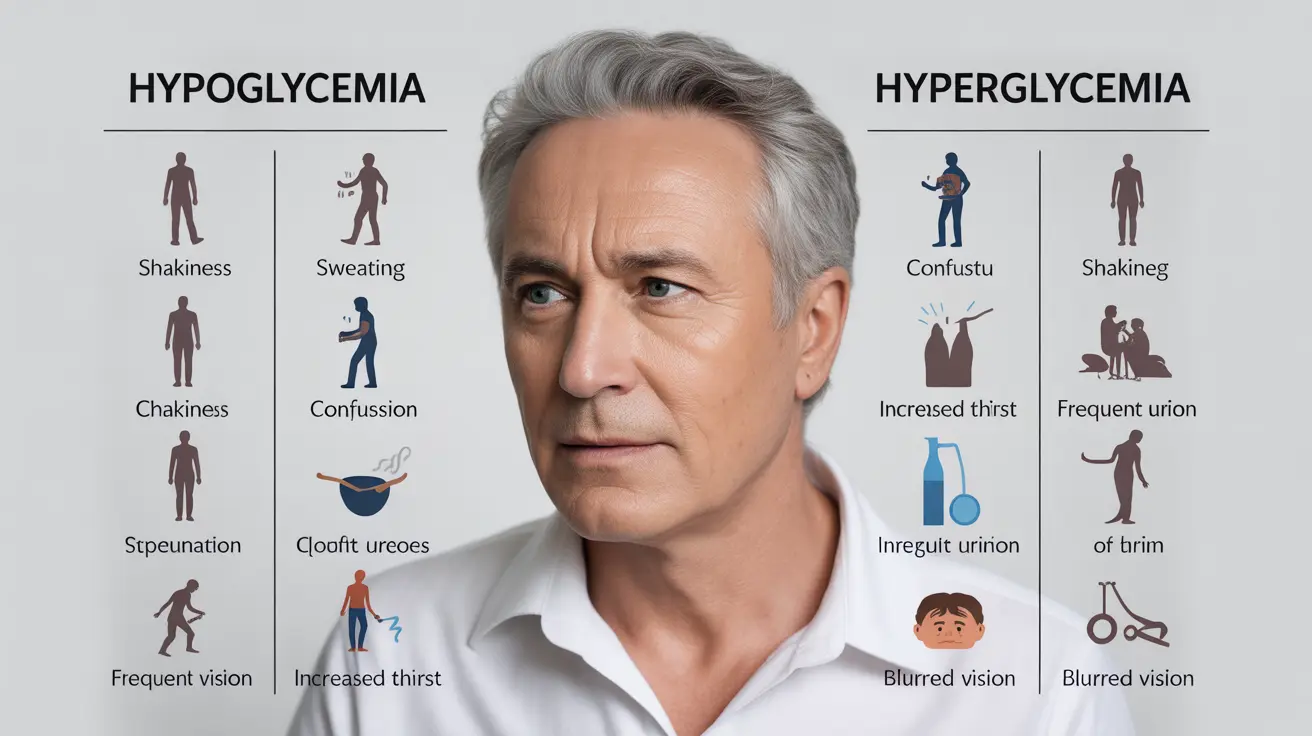Blood sugar management is crucial for overall health, particularly for people with diabetes. Two dangerous conditions can occur when blood sugar levels become unbalanced: hypoglycemia (low blood sugar) and hyperglycemia (high blood sugar). Understanding the distinct symptoms and appropriate responses for each condition can be lifesaving.
This comprehensive guide will help you distinguish between hypoglycemia and hyperglycemia, recognize their symptoms, and know when to seek immediate medical attention.
Key Symptoms of Hypoglycemia vs Hyperglycemia
Hypoglycemia Symptoms
Low blood sugar (below 70 mg/dL) typically causes:
- Shakiness and trembling
- Sudden anxiety or nervousness
- Sweating and chills
- Confusion and difficulty concentrating
- Rapid heartbeat
- Extreme hunger
- Vision changes
- Weakness and fatigue
Hyperglycemia Symptoms
High blood sugar (above 180 mg/dL) usually presents with:
- Increased thirst and frequent urination
- Fatigue and drowsiness
- Blurred vision
- Headache
- Dry mouth
- Nausea
- Slow-healing wounds
- Fruity-smelling breath (in severe cases)
Immediate Response and Treatment
Managing Hypoglycemia
When blood sugar drops too low, quick action is essential:
- Consume 15-20 grams of fast-acting carbohydrates
- Test blood sugar after 15 minutes
- Repeat treatment if levels remain low
- Follow with a small protein-rich snack once stabilized
Managing Hyperglycemia
For high blood sugar, appropriate steps include:
- Check ketones if blood sugar is very high
- Drink plenty of sugar-free fluids
- Follow your diabetes management plan
- Exercise moderately if ketones aren't present
- Monitor blood sugar levels closely
Risk Factors and Prevention
Common Causes of Blood Sugar Imbalance
Several factors can trigger these conditions:
- Medication timing or dosage issues
- Skipped or delayed meals
- Excessive physical activity
- Illness or infection
- Stress
- Alcohol consumption
- Changes in daily routine
Preventive Strategies
To minimize the risk of both conditions:
- Monitor blood sugar regularly
- Take medications as prescribed
- Maintain consistent meal timing
- Keep a glucose monitoring log
- Carry fast-acting glucose sources
- Wear medical identification
- Educate family and friends about symptoms
Emergency Warning Signs
Seek immediate medical attention if experiencing:
- Severe confusion or inability to concentrate
- Seizures
- Loss of consciousness
- Severe abdominal pain
- Difficulty breathing
- Ketones in urine
- Symptoms that don't improve with treatment
Frequently Asked Questions
- What are the main symptoms of hypoglycemia versus hyperglycemia in adults and children?
Hypoglycemia typically causes immediate symptoms like shakiness, sweating, and confusion. Hyperglycemia usually develops more gradually, with increased thirst, frequent urination, and fatigue. Children may show additional signs like irritability and difficulty concentrating.
- What should I do right away for low blood sugar (hypoglycemia) or high blood sugar (hyperglycemia)?
For hypoglycemia, immediately consume 15-20 grams of fast-acting carbohydrates and recheck blood sugar after 15 minutes. For hyperglycemia, drink sugar-free fluids, check for ketones, and follow your diabetes management plan.
- What causes blood sugar levels to drop too low or rise too high, and who is most at risk?
Common causes include medication issues, irregular meals, illness, and stress. People with diabetes, particularly those on insulin or certain diabetes medications, are at highest risk. The elderly and those with other chronic conditions may also be more vulnerable.
- How can I prevent episodes of hypoglycemia or hyperglycemia if I have diabetes?
Prevention involves regular blood sugar monitoring, consistent medication timing, maintaining meal schedules, and keeping detailed records. Working closely with healthcare providers to adjust treatment plans as needed is also crucial.
- When should someone with symptoms of low or high blood sugar seek emergency medical help?
Seek immediate medical attention for severe confusion, seizures, loss of consciousness, difficulty breathing, severe abdominal pain, or when symptoms don't improve with standard treatment measures.




